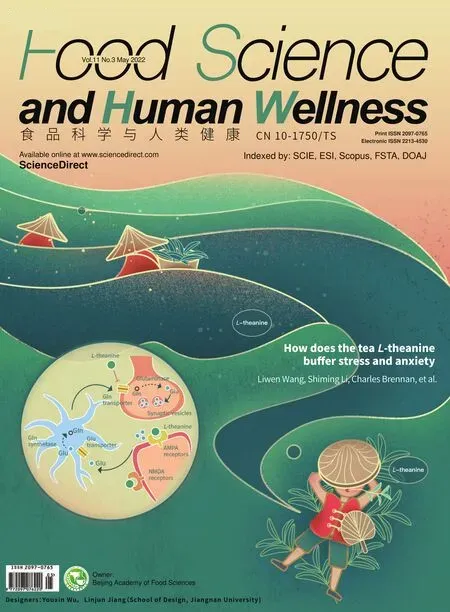食品科學(xué)與人類健康(英文)
- Focusing on the recent progress of tea polyphenol chemistry and perspectives
- Tea in cardiovascular health and disease: a critical appraisal of the evidence
- Metabolic fate of tea polyphenols and their crosstalk with gut microbiota
- How does the tea L-theanine buffer stress and anxiety
- Tea and depression
- Multifaceted neuroprotective effects of (-)-epigallocatechin-3-gallate(EGCG) in Alzheimer’s disease: an overview of pre-clinical studies focused on β-amyloid peptide
- Modulatory effects in circadian-related diseases via the reciprocity of tea polyphenols and intestinal microbiota
- Antioxidant and anti-inflammatory roles of tea polyphenols in inflammatory bowel diseases
- Multifunctional health-promoting effects of oolong tea and its products
- Multi-omics approach in tea polyphenol research regarding tea plant growth,development and tea processing: current technologies and perspectives
- Improving the stability and bioavailability of tea polyphenols by encapsulations: a review
- Management of Maillard reaction-derived reactive carbonyl species and advanced glycation end products by tea and tea polyphenols
- Health promoting activities and corresponding mechanism of(–)-epicatechin-3-gallate
- Functional mechanism on stem cells by tea (Camellia sinensis)bioactive compounds
- Structure variety and its effects on biological activity of tea polysaccharides
- Degradation of black tea thea flavin through C-ring cleavage by gut microbiota
- Comprehensive comparison on the chemical metabolites and taste evaluation of tea after roasting using untargeted and pseudotargeted metabolomics
- Characterization of aroma compounds of Pu-erh ripen tea using solvent assisted flavor evaporation coupled with gas chromatography-mass spectrometry and gas chromatography-olfactometry
- Screening of α-glucosidase inhibitors in large-leaf yellow tea by of fline bioassay coupled with liquid chromatography tandem mass spectrometry
- Selenium-enriched oolong tea (Camellia sinensis) extract exerts anti-inflammatory potential via targeting NF-κB andMAPK pathways in macrophages
- Detection of composition of functional component theabrownins in Pu-erh tea by degradation method
- Potential prebiotic effects of nonabsorptive components of Keemun and Dianhong black tea: an in vitro study
- Identification of circRNA/miRNA/mRNA regulatory net-work involving (+)-catechin ameliorates diabetic nephropathy mice
- Effect of digestive enzymes and pH on variation of bioavailability of green tea during simulated in vitro gastrointestinal digestion
- High-quality instant black tea manufactured using fresh tea leaves by two-stage submerged enzymatic processing
- Fungi with potential probiotic properties isolated from Fuzhuan brick tea
- Comparative study on the weight loss and lipid metabolism by tea polyphenols in diet induced obese C57BL/6J pseudo germ free and conventionalized mice
- Hypoglycemic effects of black brick tea with fungal growth in hyperglycemic mice model
- Determination of 19 polyphenolic compounds in tea by ultra-high performance liquid chromatography combined with quadrupole-time of flight mass spectrometry
- Fermentation characteristics and probiotic activity of a purified fraction of polysaccharides from Fuzhuan brick tea
- Selenium-enriched and ordinary green tea extracts prevent high blood pressure and alter gut microbiota composition of hypertensive rats caused by high-salt diet

